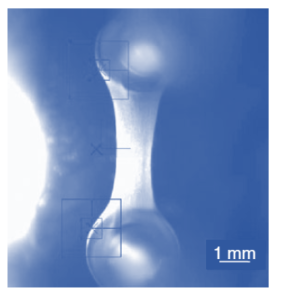Engineered Heart Tissue
The generation of miniature Engineered Heart tissue (Hansen/Eder et al. 2010) involves a construction of fibrinogen and thrombin as a hydrogel, standard 24-well culture dishes, teflon spacer casting molds in agarose, and two silicone posts per well to allow the growing muscle tissue attaches. Spontaneous contractions or electrically stimulated contractions deflect the posts and can be assayed by video-optical recording. Casting molds are produced by putting a Teflon spacer in liquid agarose. After solidification of the agarose and removal of the spacer, silicone racks with two posts per well are manually positioned in the casting molds. A reconstitution mix of cardiomyocytes, fibrinogen and thrombin is then poured into the casting mold around the silicone posts and incubated for polymerization of the fibrin at 37 °C. After 1.5 h the silicone racks with attached EHTs can be transferred to a 24-well- culture dish where the EHTs will commence coherent beating after approximately 3-7 days.
Contraction analysis of EHTs is carried out in a gas and temperature controlled incubator with a glass roof and a video camera mounted onto a motorized xyz-axis system above. EHTs in a NUNC® 24-well-dish are positioned in the incubator on top of a LED panel. A proprietary software controls the positioning of the camera above each well of the culture dish. The camera records the movement of the EHT over a set time.


Add Your Comment